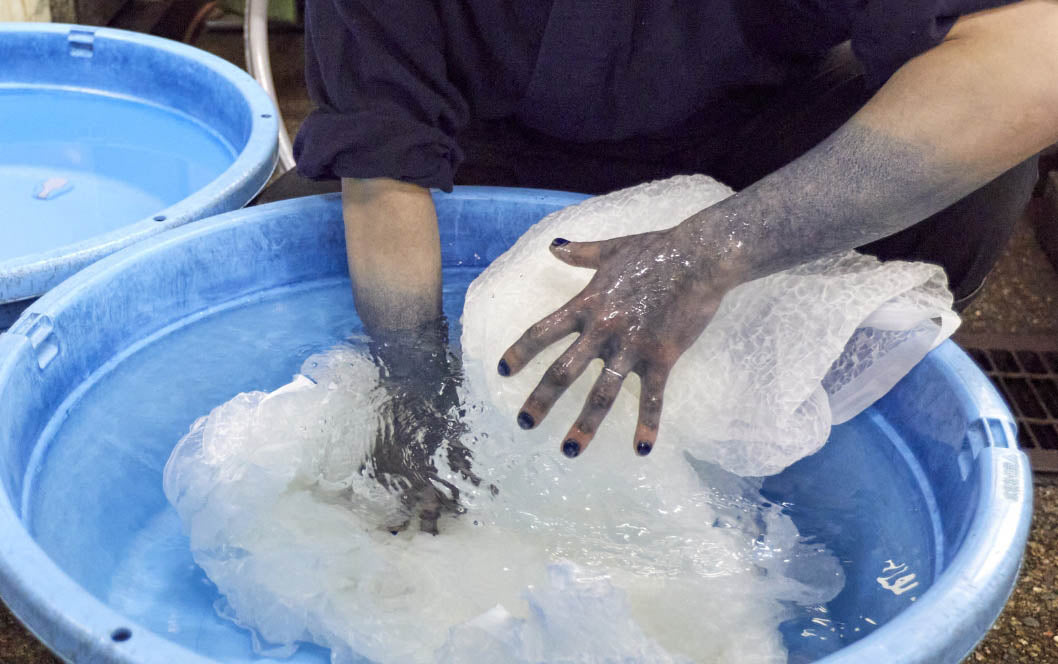
Unlimited possibilities from nature's infinite natural 「BLUE」
In the process of producing natural indigo dye, whether it's the cultivation of "tadeai" (Japanese knotweed indigo) or the fermentation process of making "sukumo" (fermented indigo dye), ingredients such as ash water, bran, lime, and sake are all derived from 100% natural components in nature. By combining carefully selected materials with techniques passed down through generations, the inherent beauty of natural indigo dye is fully realized.
-

100% Natural
In the process of producing indigo dye, whether it's the cultivation of "tadeai" (Japanese knotweed indigo) or the fermentation process of making "sukumo" (fermented indigo dye), ingredients such as ash water, bran, lime, and sake are all derived from 100% natural components in nature.
-

Fermentation of Natural Ash Water
Due to the natural fermentation process, the state of each production varies, and experienced indigo dyers rely on the "taste" sensed through the mouth to assess the fermentation status of the dye and make adjustments when preparing the dye.
-

Repetitive Dyeing Process
Indigo dyeing involves dipping fabric into dye, and the color develops after washing and oxidation. Therefore, achieving the desired color and design requires repeated steps of dyeing and washing to gradually create the final product in terms of color depth and pattern.

The Birth of 「Japan Blue」
During World War II, the cultivation of Japanese knotweed indigo, known as "tadeai," was prohibited for dye production. However, determined to preserve the tradition of indigo dyeing, Mr. Sato Heisuke, the 17th-generation successor of a Tokushima indigo dyeing house, continued cultivation with a resolve bordering on desperation. Additionally, only the Sato family in Tokushima has been able to continue cultivating "Shirahana Koagari," holding the exclusive title of "Zuiichi" since the Edo period.

Washing
Cleanse the fabric to reduce impurities, making it more receptive to dye absorption.

Hand Twist Dyeing
For thread-like fabrics soaked in indigo dye, the repeated twisting and soaking actions allow the indigo to penetrate fully. This step requires accumulated experience over time.

Rinse with Water
Rinsing with water is not only a cleansing process but also a crucial step for the oxidation of the indigo. The thoroughness of the wash affects the color presentation, often requiring hours of adjustment.

Sun-drying and Setting
Air-drying in the sun allows the indigo to penetrate the fabric's threads deeply and stabilizes the dye. The drying time varies depending on the material of the fabric and threads, typically taking several days.

Post-treatment
Based on the characteristics of the fabric's threads, various setting steps are taken to remove excess dye, revealing the ideal color of the product.

Sewing
In addition to directly dyeing entire pieces of fabric or garments in indigo, bundles of threads are also dyed to produce various shades of blue. Skilled artisans then weave these differently colored indigo threads into individual pieces of artistic textiles.
All the content, images, and videos above are from the Traditional Craft Future Project's Ai+ indigo dyeing.
-
Ai+|Japan Blue Organza Shawl
通常価格 $2,214.40 SGD通常価格単価 / あたり -
Ai+|Japan Blue Koishimaru Nishijin-ori Shawl
通常価格 $3,947.40 SGD通常価格単価 / あたり





